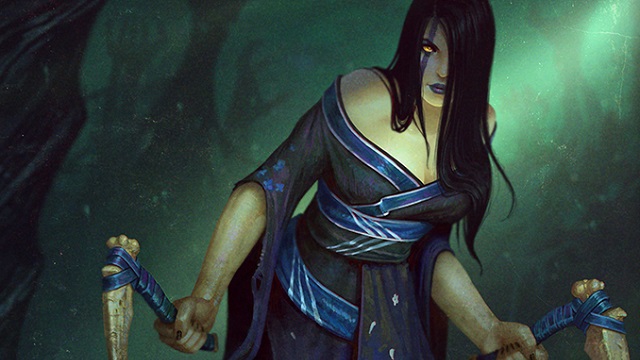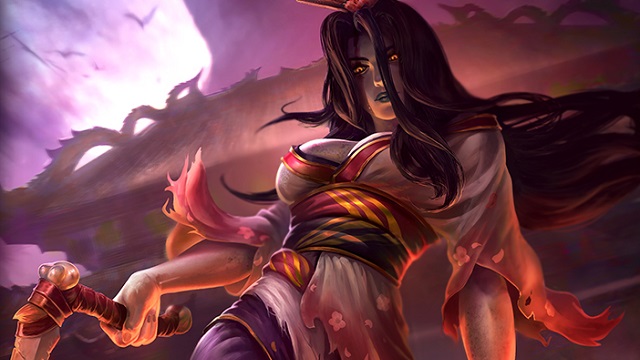SMITE, the popular third person MOBA by Hi-Rez Studios, is well known for its representations of religious and mythological deities. These deities are faithfully accurate in their depictions and histories, but most of all they are also respectful of the faiths from which they originated.
Within the last year, Hi-Rez has added a new Japanese pantheon to play with. Though not the first eastern religion to be present within the game — that honor goes to the Chinese pantheon — it was one of the most requested pantheons to be included by the game’s community.
The latest addition to the Japanese pantheon is Izanami, Matron of the Dead. Izanami is one of the most significant deities of Shinto mythology, akin to the role of Anubis or Hades in other religions. She reaps the souls of the dead and brings them to the afterlife. But how accurate is the portrayal of Izanami? Let’s compare her lore from SMITE with her real world historical lore in Shinto mythology.
In the Beginning
 In Japanese Shinto mythology, Izanami-no-Mikoto, is a goddess of both creation and death, as well as Izanagi-no-Mikoto’s former wife. She was born from the divine will of the first gods Kunitokotachi and Amenominakanushi, a divine being charged with creating the first land. Together Izanami and Izanagi journeyed to the bridge between heaven and earth and, using a divine spear, churned up the waters of the world to form an island that they would call their home.
In Japanese Shinto mythology, Izanami-no-Mikoto, is a goddess of both creation and death, as well as Izanagi-no-Mikoto’s former wife. She was born from the divine will of the first gods Kunitokotachi and Amenominakanushi, a divine being charged with creating the first land. Together Izanami and Izanagi journeyed to the bridge between heaven and earth and, using a divine spear, churned up the waters of the world to form an island that they would call their home.
Izanami’s beginnings are not clearly stated in her bio for SMITE. This may be due to the nature by which their lore flows. Often times the lore of each deity can be seen in various other deities’ bios. The connection between Izanami and Izanagi may expand on this when Izanagi eventually joins the Japanese pantheon in SMITE. For now however, without knowledge of the Shinto myths, you would have no idea where Izanami came from.
Love, Birth, and Death
The Shinto legends continue. After descending to the world, Izanami and Izanagi married and bore many children. These children became the islands of Japan, as well as the deities ruling over primal aspects of the world — such as Amaterasu, goddess of the Sun (who was the first Japanese deity to be added to the game). However, tragedy struck and Izanami died during childbirth of the god of fire, Kagu-Tsuchi. Izanagi buried her atop Mount Hiba and in a furious rage fueled by the grief of his wife’s death, he murdered his own child, Kagu-Tsuchi.
In SMITE, Izanami’s bio states the following:
As Izanami gave birth to the god of Fire, his searing skin scorched her flesh. Fearful she would die, her husband, Izanagi, the man with whom she had created the world, held her close and wept. But it was too late. So grievous were the wounds, Izanami succumbed to death.
These two stories are very much identical. While SMITE takes care to omit a few names and includes some fancied up words for dramatic effect, it remains true to its origins in Shinto legend. Her death is an important moment in the mythology, as we will soon understand.

Yomi, the Land of the Dead
Izanagi-no-Mikoto grieves for his deceased wife. Lamenting her fate he begins a journey into the shadowy realm of the dead, Yomi. He searches tirelessly for her, and eventually finds her among the darkest shadows of the land. Izanami hides amidst the darkness, preventing her husband from seeing her, but Izagani is overjoyed by his success and pleads for her to return with him and leave Yomi. Izanami declines, stating that she had already partaken of the food of the underworld and had become one with their lands. She could no longer return to the world of the living, but would seek permission from the gods.
Though he is shocked by the news, Izanagi refuses to leave without his beloved, remaining in Yomi. While Izanami sleeps that night, Izanagi uses a sacred comb which bound his long hair and sets it ablaze to use as a torch. Having pushed back the shadows and darkness he sets eyes upon his wife Izanami once again. Her body is decayed and rotten, covered in maggots and other foul pests.
In SMITE, Izanami’s bio continues:
To rescue her soul, Izanagi traveled to Yomi, the realm of the darkness and death. Through the black maze he searched, until finally he came upon her, hidden amongst the shadows. He implored her to return with him. She could not, for she had already eaten the fruit that grew in Yomi. Izanagi insisted. He would not leave her in this place. He swore it.
Izanami agreed to take her husband to see the Gods of Yomi, to implore them to free her. Meanwhile, remain in darkness, she cautioned him, for the realm of the dead was not meant for the living to see. Taken by foreboding, Izanagi lit a torch and laid eyes upon his wife. No longer the graceful, elegant beauty she once was, Izanami now appeared a rotting corpse, hollow and decayed, maggot-ridden and foul.
SMITE once again does a good job of portraying the story in a dramatic yet respectful way, including even the horrifying reveal of Izanami’s new form. Though they may have taken some liberties with Izanagi’s motivations they remain true to his devotion to finding his deceased wife. Who it is that speaks to the rulers of Yomi is unclear in the original tale, with Izanami merely stating that she would need permission to leave. However, the end result is all the same. Izanagi’s curiosity leads us into the final chapter of this bitter tale, his escape from Yomi and the fate of Izanami.
 Yomotsu Hirasaka in Higashiizumo, Shimane Prefecture, Japan
Yomotsu Hirasaka in Higashiizumo, Shimane Prefecture, Japan
The Curse of 1000 Deaths
Crying aloud after seeing his wife’s rotten form, Izanagi flees in terror and disgust. This outburst awakens Izanami, who shrieks in horrid anger, commanding the dead to seek out and capture Izanagi. However, Izanagi eludes them and escapes. Exiting into the world of the living through Yomotsuhirasaka — the cave entrance to Yomi — he seals the cavern with a giant boulder. Izanami rushes to the entrance, seeing her fate sealed within the underworld she cries out a curse upon the living, vowing to destroy one thousand lives every single day. In furious sorrow, Izanagi shouts back to her that he would give life to one thousand five hundred each day in return.
In SMITE, Izanami’s bio concludes as thus:
Frightened and disgusted, Izanagi broke his vow and fled.
Through the bowels of Yomi he ran, pursued by the fiend that was once his wife. Escaping the cave entrance, Izanagi rolled a boulder in place to block it. Sealed within, betrayed and cursed, consumed with wrathful anger, Izanami swore, one thousand lives would she take each day. One thousand to pay for the broken promise he made.
Since then, Izanami has kept her vow, each day reaching beyond the grave to pull souls to Yomi. But war has broken the boulder that once kept her sealed away, and Izanami has emerged, cold and lifeless, but burning with a vengeance against all that lives. One thousand souls will not be enough.
The finale of the story remains mostly identical, once again honoring the original tale as closely as possible. SMITE concludes its story by adding on its own spin of why Izanami once again walks among the living, free of Yomi’s cursed lands.
Overall, SMITE has been very faithful to the origins of Izanami and to Shinto mythology. Though her appearance emphasizes more on the side of her beautiful original form rather than her disgusting maggot-filled one, I believe we can all agree that is a decision that we can all live with.
If you want to try Izanami for yourself, you can play SMITE for free on PlayStation 4, XBox One, Microsoft Windows, and Mac OS. Patch 3.16, “Fatal Awakening”, for SMITE is expected to go live on August 30th, 2016.










Published: Aug 24, 2016 05:19 pm